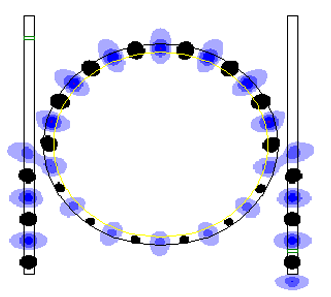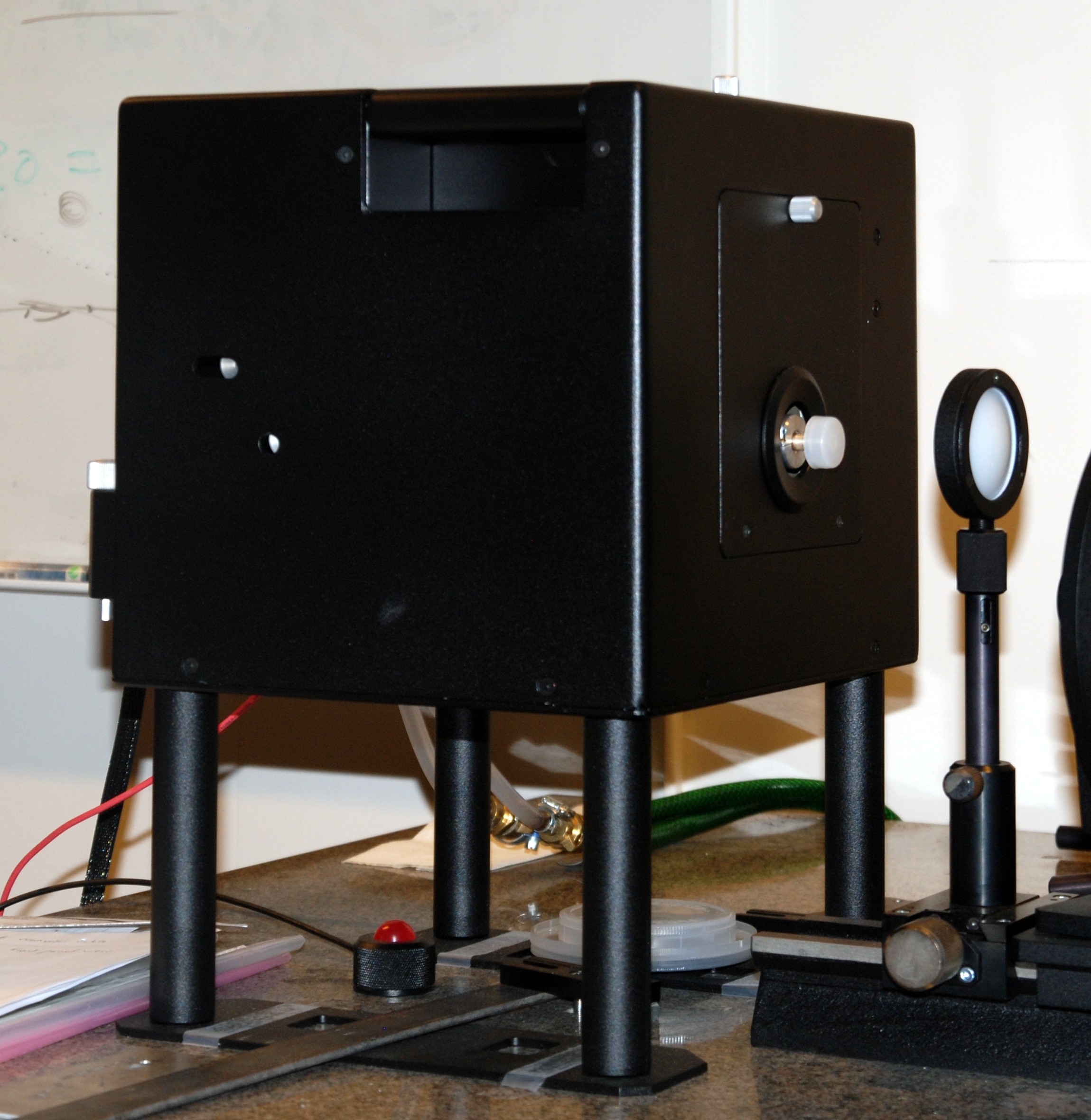|
Coupled Mode Theory
Coupled mode theory (CMT) is a perturbational approach for analyzing the coupling of vibrational systems (mechanical, optical, electrical, etc.) in space or in time. Coupled mode theory allows a wide range of devices and systems to be modeled as one or more coupled resonators. In optics, such systems include laser cavities, photonic crystal slabs, metamaterials, and ring resonators. History Coupled mode theory first arose in the 1950s in the works of Miller on microwave transmission lines,S.E.Miller,"Coupled wave theory and waveguide applications.", ''Bell System Technical Journal'', 1954 Pierce on electron beams, and Gould on backward wave oscillators.R.W. Gould, "A coupled mode description of the backward-wave oscillator and the Kompfner dip condition" ''I.R.E. Trans. Electron Devices'', vol. PGED-2, pp. 37–42, 1955. This put in place the mathematical foundations for the modern formulation expressed by H. A. Haus ''et al.'' for optical waveguides.H. A. Haus, W. P. Huang. " ... [...More Info...] [...Related Items...] OR: [Wikipedia] [Google] [Baidu] [Amazon] |
|
 |
Vibration
Vibration () is a mechanical phenomenon whereby oscillations occur about an equilibrium point. Vibration may be deterministic if the oscillations can be characterised precisely (e.g. the periodic motion of a pendulum), or random if the oscillations can only be analysed statistically (e.g. the movement of a tire on a gravel road). Vibration can be desirable: for example, the motion of a tuning fork, the reed in a woodwind instrument or harmonica, a mobile phone, or the cone of a loudspeaker. In many cases, however, vibration is undesirable, wasting energy and creating unwanted sound. For example, the vibrational motions of engines, electric motor An electric motor is a machine that converts electrical energy into mechanical energy. Most electric motors operate through the interaction between the motor's magnetic field and electric current in a electromagnetic coil, wire winding to gene ...s, or any Machine, mechanical device in operation are typically unwanted. ... [...More Info...] [...Related Items...] OR: [Wikipedia] [Google] [Baidu] [Amazon] |
 |
Photonic Crystal
A photonic crystal is an optical nanostructure in which the refractive index changes periodically. This affects the propagation of light in the same way that the structure of Crystal structure, natural crystals gives rise to X-ray crystallography, X-ray diffraction and that the atomic lattices (crystal structure) of semiconductors affect their conductivity of electrons. Photonic crystals occur in nature in the form of structural coloration and animal reflectors, and, as artificially produced, promise to be useful in a range of applications. Photonic crystals can be fabricated for one, two, or three dimensions. One-dimensional photonic crystals can be made of thin film layers deposited on each other. Two-dimensional ones can be made by photolithography, or by drilling holes in a suitable substrate. Fabrication methods for three-dimensional ones include drilling under different angles, stacking multiple 2-D layers on top of each other, direct laser writing, or, for example, instig ... [...More Info...] [...Related Items...] OR: [Wikipedia] [Google] [Baidu] [Amazon] |
 |
Metamaterials
A metamaterial (from the Greek word μετά ''meta'', meaning "beyond" or "after", and the Latin word ''materia'', meaning "matter" or "material") is a type of material engineered to have a property, typically rarely observed in naturally occurring materials, that is derived not from the properties of the base materials but from their newly designed structures. Metamaterials are usually fashioned from multiple materials, such as metals and plastics, and are usually arranged in repeating patterns, at scales that are smaller than the wavelengths of the phenomena they influence. Their precise shape, geometry, size, orientation, and arrangement give them their "smart" properties of manipulating electromagnetic, acoustic, or even seismic waves: by blocking, absorbing, enhancing, or bending waves, to achieve benefits that go beyond what is possible with conventional materials. Appropriately designed metamaterials can affect waves of electromagnetic radiation or sound in a manner not ... [...More Info...] [...Related Items...] OR: [Wikipedia] [Google] [Baidu] [Amazon] |
 |
Optical Ring Resonators
An optical ring resonator is a set of waveguides in which at least one is a closed loop coupled to some sort of light input and output. (These can be, but are not limited to being, waveguides.) The concepts behind optical ring Optical cavity, resonators are the same as those behind Whispering gallery, whispering galleries except that they use light and obey the properties behind constructive interference and total internal reflection. When light of the resonant wavelength is passed through the loop from the input waveguide, the light builds up in intensity over multiple round-trips owing to constructive interference and is output to the output bus waveguide which serves as a detector waveguide. Because only a select few wavelengths will be at resonance within the loop, the optical ring resonator functions as a filter. Additionally, as implied earlier, two or more ring waveguides can be coupled to each other to form an add/drop optical filter. Background Optical ring resonators w ... [...More Info...] [...Related Items...] OR: [Wikipedia] [Google] [Baidu] [Amazon] |
 |
Transmission Lines
In electrical engineering, a transmission line is a specialized cable or other structure designed to conduct electromagnetic waves in a contained manner. The term applies when the conductors are long enough that the wave nature of the transmission must be taken into account. This applies especially to radio-frequency engineering because the short wavelengths mean that wave phenomena arise over very short distances (this can be as short as millimetres depending on frequency). However, the theory of transmission lines was historically developed to explain phenomena on very long telegraph lines, especially submarine telegraph cables. Transmission lines are used for purposes such as connecting radio transmitters and receivers with their antennas (they are then called feed lines or feeders), distributing cable television signals, trunklines routing calls between telephone switching centres, computer network connections and high speed computer data buses. RF engineers comm ... [...More Info...] [...Related Items...] OR: [Wikipedia] [Google] [Baidu] [Amazon] |
|
Electron Beam
Since the mid-20th century, electron-beam technology has provided the basis for a variety of novel and specialized applications in semiconductor manufacturing, microelectromechanical systems, nanoelectromechanical systems, and microscopy. Mechanism Free electrons in a vacuum can be manipulated by Electric field, electric and magnetic fields to form a fine beam. Where the beam collides with solid-state matter, electrons are converted into heat or kinetic energy. This concentration of energy in a small volume of matter can be precisely controlled by the fields, which brings many advantages. Applications Electron beam techniques include electron probe microanalysis, transmission electron microscopy, auger spectroscopy, and scanning electron microscopy. The rapid increase of temperature at the location of impact can quickly melt a target material. In extreme working conditions, the rapid temperature increase can lead to evaporation, making an electron beam an excellent tool in heating ... [...More Info...] [...Related Items...] OR: [Wikipedia] [Google] [Baidu] [Amazon] |
|
 |
Backward Wave Oscillator
A backward wave oscillator (BWO), also called carcinotron or backward wave tube, is a vacuum tube that is used to generate microwaves up to the Terahertz radiation, terahertz range. Belonging to the traveling-wave tube family, it is an electronic oscillator, oscillator with a wide electronic tuning range. An electron gun generates an electron beam that interacts with a slow-wave structure. It sustains the oscillations by propagating a traveling wave backwards against the beam. The generated electromagnetic wave power has its group velocity directed oppositely to the direction of motion of the electrons. The output power is coupled out near the electron gun. It has two main subtypes, the M-type (M-BWO), the most powerful, and the O-type (O-BWO). The output Power (physics), power of the O-type is typically in the range of 1 Watt, mW at 1000 GHz to 50 mW at 200 Hertz, GHz. Carcinotrons are used as powerful and stable microwave sources. Due to the good quality wavefront ... [...More Info...] [...Related Items...] OR: [Wikipedia] [Google] [Baidu] [Amazon] |
 |
Nanophotonics
Nanophotonics or nano-optics is the study of the behavior of light on the nanometer scale, and of the interaction of nanometer-scale objects with light. It is a branch of optics, optical engineering, electrical engineering, and nanotechnology. It often involves dielectric structures such as nanoantennas, or metallic components, which can transport and focus light via surface plasmon polaritons. The term "nano-optics", just like the term "optics", usually refers to situations involving ultraviolet, visible, and near-infrared light (free-space wavelengths from 300 to 1200 nanometers). Background Normal optical components, like lenses and microscopes, generally cannot normally focus light to nanometer (deep subwavelength) scales, because of the diffraction limit ( Rayleigh criterion). Nevertheless, it is possible to squeeze light into a nanometer scale using other techniques like, for example, surface plasmons, localized surface plasmons around nanoscale metal objects, and ... [...More Info...] [...Related Items...] OR: [Wikipedia] [Google] [Baidu] [Amazon] |
 |
Fano Resonance
In physics, a Fano resonance is a type of resonant scattering phenomenon that gives rise to an asymmetric line-shape. Interference between a background and a resonant scattering process produces the asymmetric line-shape. It is named after Italian-American physicist Ugo Fano, who in 1961 gave a theoretical explanation for the scattering line-shape of inelastic scattering of electrons from helium; however, Ettore Majorana was the first to discover this phenomenon. Fano resonance is a weak coupling effect meaning that the decay rate is so high, that no hybridization occurs. The coupling modifies the resonance properties such as spectral position and width and its line-shape takes on the distinctive asymmetric Fano profile. Because it is a general wave phenomenon, examples can be found across many areas of physics and engineering. History The explanation of the Fano line-shape first appeared in the context of inelastic electron scattering by helium and autoionization. The inciden ... [...More Info...] [...Related Items...] OR: [Wikipedia] [Google] [Baidu] [Amazon] |
 |
Maxwell's Equations
Maxwell's equations, or Maxwell–Heaviside equations, are a set of coupled partial differential equations that, together with the Lorentz force law, form the foundation of classical electromagnetism, classical optics, Electrical network, electric and Magnetic circuit, magnetic circuits. The equations provide a mathematical model for electric, optical, and radio technologies, such as power generation, electric motors, wireless communication, lenses, radar, etc. They describe how electric field, electric and magnetic fields are generated by electric charge, charges, electric current, currents, and changes of the fields.''Electric'' and ''magnetic'' fields, according to the theory of relativity, are the components of a single electromagnetic field. The equations are named after the physicist and mathematician James Clerk Maxwell, who, in 1861 and 1862, published an early form of the equations that included the Lorentz force law. Maxwell first used the equations to propose that ligh ... [...More Info...] [...Related Items...] OR: [Wikipedia] [Google] [Baidu] [Amazon] |
|
Helmholtz Equation
In mathematics, the Helmholtz equation is the eigenvalue problem for the Laplace operator. It corresponds to the elliptic partial differential equation: \nabla^2 f = -k^2 f, where is the Laplace operator, is the eigenvalue, and is the (eigen)function. When the equation is applied to waves, is known as the wave number. The Helmholtz equation has a variety of applications in physics and other sciences, including the wave equation, the diffusion equation, and the Schrödinger equation for a free particle. In optics, the Helmholtz equation is the wave equation for the electric field. The equation is named after Hermann von Helmholtz, who studied it in 1860. from the Encyclopedia of Mathematics. Motivation and uses The Helmholtz equation often arises in the study of physical problems involving par ...[...More Info...] [...Related Items...] OR: [Wikipedia] [Google] [Baidu] [Amazon] |
|
|
Variational Principle
A variational principle is a mathematical procedure that renders a physical problem solvable by the calculus of variations, which concerns finding functions that optimize the values of quantities that depend on those functions. For example, the problem of determining the shape of a hanging chain suspended at both ends—a catenary—can be solved using variational calculus, and in this case, the variational principle is the following: The solution is a function that minimizes the gravitational potential energy of the chain. History Physics The history of the variational principle in classical mechanics started with Maupertuis's principle in the 18th century. Math Felix Klein's 1872 Erlangen program attempted to identify invariants under a group of transformations. Examples In mathematics * Ekeland's variational principle in mathematical optimization * The finite element method * The variation principle relating topological entropy and Kolmogorov-Sinai entropy. In physics * ... [...More Info...] [...Related Items...] OR: [Wikipedia] [Google] [Baidu] [Amazon] |